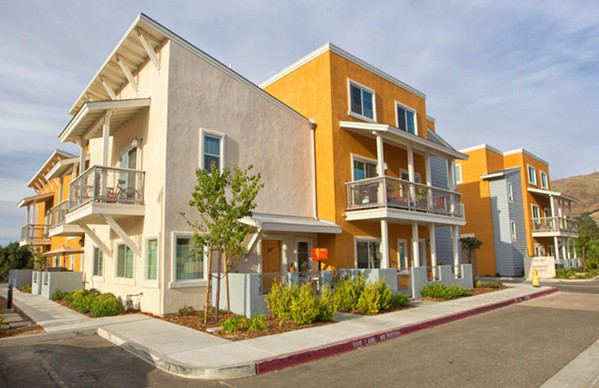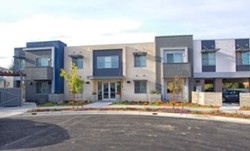The lifeblood of fiscal opportunity flows through the only major artery in San Luis Obispo County twice a day. Cars clog Highway 101 like clockwork starting around 4:30 p.m. each weeknight, when headlights drive north and south, away from the county's core and into its outer reaches.
San Luis Obispo is the beating heart of the county's economic engine: 19,000 to 25,000 workers pump the city to life every morning and flood back to their homes each night.

- Photo By Jayson Mellom
- INCLUSIONARY UNITS Affordable housing units like these on Lavender Lane and Humbert Avenue were built by leveraging inclusionary housing funds from both San Luis Obispo county and city to pull in outside money.
Those homes are often a 30-mile or more commute away in areas like Santa Maria, Paso Robles, and San Miguel—areas that are considered to be "affordable" places to live, where you can purchase a home for the median price of between $330,000 and $450,000 rather than $550,000.
However, those places are outliers in a regional market where the median price of a home holds steady with the rest of California while its median household income is about $20,000 less than the state's average. In fact, SLO County is considered to have the 10th least affordable housing market in the country and the fourth least affordable small market, according to the 2050 regional growth forecast released by the San Luis Obispo Council of Governments and Beacon Economics in June 2017. Only 21 percent of family households could afford a median-priced home in the last quarter of 2016.
That crunch is something area businesses such as Synergy Manufacturing feel acutely, both in recruiting efforts and for already existing employees. The company designs after-market automotive products specializing in off-roading vehicles, with clients across the nation and in places like Europe and the Middle East.
Ian Ferguson, Synergy's general manager, said the company pays most of its management and upper management positions at above median income levels (that would be about $45,000 or higher, according to the numbers proffered at the Central Coast Economic Forecast on Nov. 3), but SLO County's housing market can be a deal breaker.
"It's difficult from a recruitment standpoint. We're currently right now trying to find a marketing/media person and there's kind of a going rate for that position and unless that person comes in with dual incomes, it's kind of hard for he or she to be able to move to this area," Ferguson said. "We've had a few people leave the area that are what I would consider high-skilled labor; they were equipment operators and welders."
Synergy's marketing person was one of those people who left due to the area's housing issues. He and his wife had a baby, and long-term they couldn't see the economic feasibility of staying in the area. So they went elsewhere.
But the retail side of things is just one side of the housing market that can make life difficult for Synergy employees. It's the rental market as well—both prices and availability.
And every time one of their employees gets into a housing dilemma, it affects work. Ferguson said their IT guy lived in the same house for six years before getting kicked out because the owners wanted to move a relative into the place. He's lived in four different spots since then, and his rent goes up every year. The employee moved out of his last place because the rent increased so much, he just decided it wasn't worth it to stay.
That constant flux creates instability, which can affect productivity and increase stress.
"It kind of grinds it to a halt, because we're a small business. When you're a small business, everyone lifts a huge weight," he said. "We have departments that are single individuals; everyone operates on their own."
Ferguson said, the recently approved housing projects—720-home Avila Ranch and 580-home San Luis Ranch developments—in the city of SLO could help the predicament. At least it's a start.
"I think we really need to be conscious about increasing the quantity of units that are built per year, because what we are really suffering from is a lack of inventory and that keeps driving prices up year over year," he said.
Affordability problem
According to the Regional Housing Needs Assessment, while the county has produced 151 percent of the homes it needed for people with above moderate income, it has otherwise only developed 24 percent of the projected regional housing needed over the past four years. Moderate income is considered to be about $99,850 for a four-person household, according to the state Department of Housing and Community Development.
That moderate income can afford to purchase a three-bedroom house for $363,475, according to the state. The median home price in SLO County is nearly $200,000 higher than that.
Bruce Gibson, 2nd District supervisor, said that simply increasing the supply of housing units available isn't going to fix the problem.

- Photo By Jayson Mellom
- HOMES FOR THE HOMELESS The Housing Authority of San Luis Obispo built 860 on the Wye project, a 20-unit apartment to house low-income homeless veterans, earlier this year.
He's a proponent of building things like deed-restricted housing (which caps the price of a home at below market rate), creating a revolving fund that area nonprofits can utilize to build those units, and upping the ante on the county's inclusionary housing ordinance—something the board majority is advocating to get rid of.
"I fully understand that we are not going to be able to build enough deed-restricted housing to take care of this, but the question is are we actually going to do anything at all rather than just talk about this?" Gibson said. "None of the other policy proposals coming forward actually put affordable housing on the ground. ... No one has told me what it takes to move the needle on the market, and no one has shown me that a market rate house is going to be affordable."
The county's inclusionary housing ordinance was adopted in 2008. It basically requires developers to produce a percentage of affordable housing with any projects they build. If developers don't want to build those affordable units, they can instead pay a fee per square foot into the county's inclusionary housing fund. Those dollars are then allocated to nonprofits like People's Self-Help Housing, which can leverage it to build affordable units.
"The basic idea is that if you're going to build 100 homes, 20 percent of those should be made affordable by deed-restricting them," Gibson explained.
Inclusionary housing opponents argue that the county's ordinance hasn't done what it was designed to do and just makes building homes that much more expensive—a cost that gets passed along to homebuyers.
"One reason it hasn't raised much is we haven't implemented it as fully as we should," Gibson said, adding that it was designed to be ramped up over time and hasn't made it past year two out of five. The county only recently opted to move up to the second tier for the 2017-18 fiscal year.
Since 2009, the county has collected $1.14 million in inclusionary fees and assisted with building 377 units of housing, according to Ted Bench, the county's senior planner in Housing and Economic Development.
"The inclusionary housing ordinance is one tool that helps produce affordable housing units for low-income households, and it has worked," Bench wrote in an email.
He said that the original intent of the ordinance was to mix affordable units into new developments, but the recession came and the five-year phase-in process didn't make it to its full potential, therefore inclusionary housing requirements were kept low. The year-two requirement for residential projects is to set aside 6 percent of units as affordable or pay $1.50 a square foot. If it ever becomes fully phased in, the ordinance would require 15 percent of units get set aside or an in-lieu payment of $3.75 per square foot.
"Nearly all projects have elected to pay the in-lieu fee rather than construct units onsite," according to a recently completed draft of a nexus study (required every five years) on the county's inclusionary housing ordinance.
"[The] nexus study says the housing market is producing units that are affordable [for] moderate and workforce buyers in certain areas of the county. But it is not producing housing that is affordable to low- and very low-income buyers," Bench said.
Raise the tide
Simply put, the study suggests that the county tier its inclusionary housing program. It recommends that the county get rid of the year-over-year need to approve increases and tier the fee based on the size of the homes being built: exempt units that are 1,600 square feet or smaller and step up the in-lieu fee for larger houses.
The thought is that such tiers will create an incentive to build smaller-sized—and therefore, more affordable—units. And right now, the market is SLO County is incentivizing builders to do exactly the opposite of that, according to Andrew Hackleman, the Homebuilders Association of the Central Coast's new executive director.
"You can't really build a house here for less than $500,000," he said. "If you're taking a property and buying it here for development, you're taking a decade[-long] risk—that's if it gets approved."
The long, arduous planning process; fee structures; and cost of land, Hackleman said, all push builders to construct "the biggest, most expensive house they can build to maximize their profits because the risk is so high." More often than not, those homes are built as 10-unit projects, rather than 100-plus units. According to the nexus study, SLO County's planning, building, and impact fees add up to about $11,482 per single-family unit (2,000 square feet) and $10,612 for each multi-family unit (1,500 square feet). That doesn't include water or wastewater connection or county road fees.
"It takes scale to be able to build affordable-by-design," Hackleman said. "There's nothing in the process that makes it attractive to try to do the housing builds that would benefit you and I."
But everybody sees that there is a problem right now, Hackleman said: There isn't a lot of housing, and it's really expensive.
Earlier this year, the Homebuilders Association advocated for a repeal of the county's inclusionary housing ordinance. The executive director at the time spoke with New Times: "We've always been opposed to the inclusionary housing ordinance," Jeff Eckles said in July. "The big problem we've got is the funding mechanism. Economic studies have shown that the more layers of fees you put on housing, the higher the price of the house."
The ordinance as it stands now simply isn't working, Hackleman said. It hasn't created a large number of affordable units. However, he also said that the Homebuilders Association is more amenable to the tiered approach to inclusionary that was recommended in the recently released nexus study—as long as it is part of a larger package of tools the county implements to chip away at the affordable housing issue—part of "a tide that raises all housing."

- Photo By Jayson Mellom
- SENIOR APARTMENTS In 2015, People's Self-Help Housing used $100,090 in county inclusionary housing funding to help build 85 affordable housing units, including this 20-unit complex for seniors in Morro Bay.
"It may be necessary, but not sufficient to solve all the problems," he said. "Let's find ways to make this a community burden rather than just on the builders."
That package would include things that the association, the Economic Vitality Corporation, and the SLO Chamber of Commerce recommended in a report accepted by the county Board of Supervisors in October 2016. It includes policy changes such as streamlining permitting, encouraging affordable-by-design construction, increasing density in certain areas, levying fees that fit the size of each unit, creating a revolving fund, and taking a look at zoning.
Hackleman said that tackling the county's housing problem is going to take a multi-pronged approach that has all the stakeholders at the decision table—differing political ideologies, profit and nonprofit builders, the business community.
"Working together sometimes requires some flexibility, and we all want the same thing," he said.
Impact to growth
One of the tools that the county is currently pulling together is what's called a constraints map. It's something that 5th District Supervisor Debbie Arnold has advocated for since she stepped into office. The map was a recommendation suggested in the report approved by supervisors in October 2016. It would basically be a quick overview of the county, showing areas that contain sensitive habitat, what the available water resources are, where the roads are or aren't needed, what density is allowed, the zoning, what the impact fees are, etc.
"All of that adds to the cost of a house. ... It's not just the price of the land and the price of a home anymore," Arnold said. "All of the things that a developer might want to do to make an affordable housing project, and they can say, 'Bingo, there's the place that I can build and make things affordable."
Arnold said she would also like to see lower impact fees, including a repeal of the inclusionary housing ordinance.
People such as John Fowler with People's Self-Help Housing hope that the recently completed draft nexus study will change people's minds about inclusionary housing. The money generated by the ordinance is invaluable to organizations like his, which need some local funding to leverage for projects.
"The money that we collect locally is really very small but we have to have it because if you don't have local money, you can't bring in the other money," Fowler said. "There has to be some local money, soft money, that goes into these things. We try and get creative about where we get it, how it comes in."
In 2016, People's Self-Help was able to take $125,000 in soft funding from the county's affordable housing program (in-lieu fees) and leverage it to build at least 51 units of affordable housing. The draft nexus study notes that the county could be doing more to facilitate building similar units and is behind neighboring counties in terms of its inclusionary housing ordinance. Monterey County requires 20 percent of homes built to be below market value with no in-lieu fee available to builders, while Santa Barbara requires 15 percent with an in-lieu fee.
A version of the study will be presented to the county supervisors on Dec. 12, when they are expected to vote on whether to leave the ordinance as is, repeal it, or follow the recommendation.
"I have never been a fan of inclusionary housing," Arnold said. "Because there is a point where you're asking somebody who's just barely getting into a home to pay for the home of somebody else. And that could be the difference for those people on whether they can get into those homes or not."
But at this point, SLO County seems to be more of a second-home buyers' market than anything, simply because that's who can afford to buy. Robert Kleinhenz, executive director of research at Beacon Economics, said one of the hard things about SLO County is its low wages relative to the state, which makes it a hard place for people to move to and be able to support a family.
"One of the big challenges at this time—for not just San Luis Obispo County but for other places, in part, that face this quandary—[is] that home prices are not just determined by median incomes, but are determined by people who are buying second homes there," Kleinhenz said. "In order to ensure that the economy can grow in the future, it has to attract a labor force that is going to be willing to take those jobs, and it's a challenging situation."
Coming out of the 2008 recession, SLO County created jobs much faster than it created housing, but now that growth is pretty much maxed out. Generally speaking, Kleinhenz said a region needs one housing unit for every 1.5 jobs, but SLO County has about 3.5 jobs per unit. Basically, the county needed to build approximately 5,000 units between 2015 and 2020 to keep up with growth. The county has to build about 1,000 units a year through 2020 to accommodate that.
"I think we're probably going to fall short by some margin," Kleinhenz said. "Things are improving. It's just that there is still a long road to get to the point where we're matching our housing needs to the job conditions that are happening, and until we get to that point, we're going to have slow growth." Δ
Reach Editor Camillia Lanham at [email protected].
Comments (5)
Showing 1-5 of 5